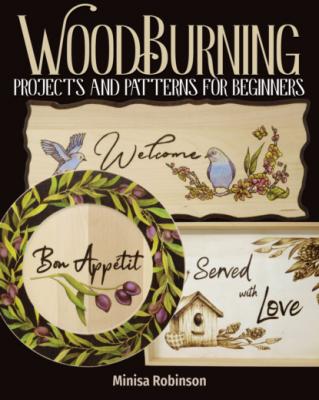Woodburning Projects and Patterns for Beginners. Minisa Robinson
Читать онлайн.| Название | Woodburning Projects and Patterns for Beginners |
|---|---|
| Автор произведения | Minisa Robinson |
| Жанр | Сделай Сам |
| Серия | |
| Издательство | Сделай Сам |
| Год выпуска | 0 |
| isbn | 9781607657828 |
Woodburning Units
There are two main types of woodburners: soldering-iron type burners with interchangeable solid points, and units with interchangeable wire pens and nibs. There are many popular woodburners within each group, which allows artists to make their selection based on personal preference. People often ask me what is the “best” woodburning tool on the market, and I encourage them to find the one that best suits their style of burning. What works best for me may not work well for others, and likewise, other artists’ preferences don’t always work with my style. Sometimes it can take trial and error to see what works best for you.
Some artists convince themselves early in their learning curve that they could create better work if only they had better tools. While sometimes this can be the case, usually the quality of one’s work comes from practice and learning the tools you have. The artist uses the tools; the tools don’t make the artist. Great art is possible with simple tools.
I have both the Walnut Hollow® Creative Versa-Tool® and the Razertip® dual pen system, but I use the Versa-Tool for most of my work. Both units are very nice, but once again this comes down to my personal preference.
Walnut Hollow Creative Versa-Tool
This woodburning kit can be found at most craft stores and big-box retailers within the United States. It is a soldering-iron type burner and has a variable temperature control plus 11 interchangeable points. Once plugged in and turned on, the burner will reach optimal temperature in about five minutes but maintains a steady and consistent heat while burning.
Razertip SS-D10
This unit is found through online retailers and uses interchangeable wire tip pens and nibs. The pens are usually purchased separately since there are many to choose from, and they vary greatly based on the needs of the artist. The Razertip also comes with a variable temperature feature and reaches the optimal temperature almost instantly once turned on. This burner can also reach much higher temperatures to burn very hard woods or bone.
Woodburning Points: Walnut Hollow Overview
The Walnut Hollow Creative Versa-Tool comes with several different points, which can be very versatile. I’ve made a chart to help show the different burn styles that you can create with each point. These are only a few ideas, and I encourage you to experiment with each point to learn what works best for you.
Tip
The brass points can be modified to suit your needs. They can be easily bent or can be sanded to create a smoother edge. If damaged, the points can be purchased individually from Walnut Hollow.
Versa-Tool: Universal Point
Side-Shading. Using the side of the bevel, drag the point sideways to create soft shading. (Sand the edge of the point if it’s too sharp.)
Crisp Lines. Drag the sharp edge of the bevel downward to create crisp lines.
Grass. Turn the point upside down and use the upper edge of the point to drag upward in random strokes. This can create the illusion of grass.
Fur. Burn fur by drawing varied upward strokes. Then use side-shading to soften and blend them together.
Stippling/Pointillism. Use the upper point to create a unique stippling effect.
Solid Black. Very similar to side-shading, use the side of the bevel and drag very slowly in a horizontal motion.
Downward Triangles. Using the upper point, press into the wood to create a downward triangle.
Varied Lines. You can create lines of different thicknesses by tipping the universal point to the side and laying it flatter against the wood.
Upward Triangles. Using the lower point, press into the wood to create an upward triangle.
Boxes and Windows. Lightly press the front edge of the point into the wood to create each edge of a small box or window.
Crosshatching. Use the sharp edge of the point to create bold crosshatching.
Versa-Tool: Flow Point
Text. Burn text much like you’d use a pencil. Be sure to set the point down in a smooth motion, much like an airplane, to prevent those “stop spots.”
Stippling. One of my favorite uses of this tip is to create unique textures through stippling. Press the point straight into the wood to make a circle-shaped indentation.
Grass and Fur. Use an upward stroke to create grass and fur textures. Because the point is larger, the grass or fur will have a softer and more blended feel.
Borders and Solid Black. The flow point is great for burning dark outlines and for blocking in solid areas of black. I often use this technique for filling in larger text.
